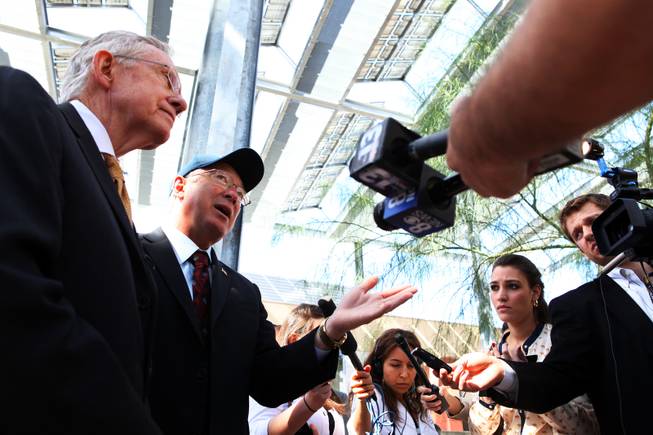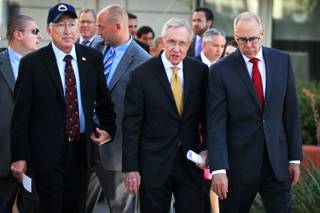
Interior Secretary Ken Salazar and Senate Majority Leader Harry Reid, D-Nev. talk to the media after an event announcing the establishment of solar energy zones on large areas of Bureau of Land Management land in six Western states at UNLV in Las Vegas on Friday, October 12, 2012.
Published Friday, Oct. 12, 2012 | 12:10 p.m.
Updated Friday, Oct. 12, 2012 | 5:30 p.m.
Related document
U.S. officials have finalized a plan to spur solar-energy projects on federal lands in Nevada and other Western states.
And Sen. Harry Reid, a staunch advocate, made sure to take a jab at Nevada’s largest electricity provider, saying NV Energy refuses to consider some clean-energy efforts.
At a press conference Friday at UNLV, Interior Secretary Ken Salazar signed the incentive plan, known as the “Programmatic Environmental Impact Statement.” It designates 17 solar energy zones in six states totaling nearly 285,000 acres. Nevada has five zones, comprising about 60,400 acres.
Officials say the zones are well-suited for large-scale solar projects, with Salazar calling them “sweet spots.” The zones have access to existing or planned transmission lines, and developers would receive expedited permitting if they build there. More zones could eventually be added.
Under the program, developers would acquire a right-of-way to build on U.S. Bureau of Land Management property and then pay royalties to the government. Payment levels are based on the amount of acreage involved and the value of the right-of-way, Salazar said.
“We’re basically mapping out the future of solar energy,” he said.
Reid, the Senate majority leader, said a dozen renewable energy projects were completed in Nevada in the last four years under President Barack Obama, a fellow Democrat, while there were none in Nevada under Obama’s predecessor, Republican President George W. Bush.
Before 2009, there were no solar energy projects permitted on public lands, according to the Interior Department.
Reid pointed out that many members of the Moapa Paiutes live near NV Energy’s Reid Gardner Generating Station, a coal-fueled, steam-electric generating plant northeast of Las Vegas.
He said tribal members have “begged” the utility to work with them on clean energy efforts, but the company “wouldn’t even talk to them.”
Instead, he noted, a project will be built there with the Los Angeles Department of Water and Power. That agency recently approved two deals to help meet the city’s renewable energy goals. One project, from energy producer K Road Power, would include a solar plant on Moapa land.
Nevada’s renewable energy portfolio standard has been described as one of the most aggressive in the country, requiring 25 percent of electricity in the state to come from renewable sources by 2025. NV Energy has been criticized for buying wind power from Wyoming, geothermal from Utah and hydropower from Idaho dams to help it meet that threshold.
On Friday, Reid said the company “has done everything they can to avoid” the requirement.
Reid has been critical of NV Energy in the past. In August, kicking off the fifth annual National Clean Energy Summit in Las Vegas, he called on NV Energy to shut down Reid Gardner.
In a statement that didn't address Reid's Friday criticisms, NV Energy spokeswoman Jennifer Schuricht said: "To the extent that this accelerates federal permitting for energy projects in Nevada, it is another proactive step in helping our state maximize its natural resources."
The plan signed by Salazar is not the only approach taken by the U.S. government to spur clean-energy projects.
Obama in August announced that seven solar and wind energy projects — including in Nevada, Arizona and California — would be expedited.
The projects are expected to produce nearly 5,000 megawatts combined, or enough power for about 1.5 million homes.
One of Nevada’s projects, K Road Power’s 200-megawatt Moapa Solar Energy Center, would be one of the first large-scale solar projects on U.S. tribal lands.
The other project, the Silver State South Solar Energy project near Primm, would bring a solar-energy generation plant to 13,043 acres of public property. The plant would produce an estimated 350 megawatts of clean energy, enough to power about 105,000 homes.
Other projects have already been built or are under way.
Silver State North, a companion project to Silver State South, was the first solar project the Interior Department approved for public lands in Nevada. Salazar “flipped the switch” on the project, also located near Primm, in May. The 50-megawatt plant is expected to generate enough power for about 9,000 homes.
And near Tonopah, a subsidiary of Santa Monica-based SolarReserve LLC will own and operate the 110-megawatt Crescent Dunes Solar Energy Project. That project will be built on BLM land, and the developer has a 25-year agreement with NV Energy to sell all of the electricity generated by the plant.
Construction started last September and is expected to be completed late next year.
The BLM administers 67 percent of Nevada’s land base, and the agency says this creates ample opportunity to help meet Nevada’s renewable energy goal.


Join the Discussion:
Check this out for a full explanation of our conversion to the LiveFyre commenting system and instructions on how to sign up for an account.
Full comments policy